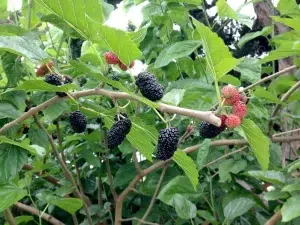Why Are Mulberry Trees Illegal?
Mulberry trees, known for their delicious berries and historical significance, have found themselves in the middle of controversy in certain areas. Despite their beauty and usefulness, some cities and regions have declared these trees illegal. This blog will explore the reasons behind these bans, the impact on local communities, and the broader environmental and health considerations.
Mulberry Trees
Mulberry trees (genus Morus) have been cultivated for thousands of years. They are cherished for their fruits, which can be eaten fresh, dried, or used in various culinary applications. The leaves of the white mulberry (Morus alba) are also the primary food source for silkworms, making the tree significant in the silk industry. However, the same characteristics that make mulberry trees desirable can also contribute to problems in urban settings.
Overview of Illegality
Mulberry trees are banned in specific regions, notably in some cities in the Southwestern United States, like Phoenix, Arizona, and Las Vegas, Nevada. These bans stem from a combination of health concerns, maintenance issues, and environmental impact.
Reasons for the Ban
Pollen Allergies
One of the primary reasons for the illegality of mulberry trees is their high pollen production. Male mulberry trees are prolific producers of pollen, which can lead to severe allergic reactions in sensitive individuals. During the pollination season, these trees release large quantities of pollen into the air, exacerbating respiratory issues such as asthma and hay fever. Municipalities seeking to improve air quality and public health often cite these allergies as a key reason for the ban.
Maintenance Issues
Mulberry trees are notorious for their maintenance challenges. The trees produce a significant amount of fruit, which can create a mess when it falls to the ground. This fallen fruit can attract pests, including insects and rodents, and can also stain sidewalks and driveways. The cleanup required to manage this fruit can be burdensome for both private property owners and municipal maintenance crews.
Environmental Impact
While mulberry trees can thrive in a variety of environments, they can sometimes become invasive, outcompeting local flora and disrupting local ecosystems. Their aggressive growth can overshadow and crowd out native plant species, reducing biodiversity. In regions where mulberries are not native, their impact on the environment can be particularly pronounced, leading to long-term ecological consequences.
Related Posts:
Case Studies
Phoenix, Arizona
Phoenix implemented a ban on planting new mulberry trees in the late 20th century, primarily due to health concerns related to pollen allergies. The city has experienced significant population growth, and with it, an increase in respiratory issues among residents. By banning mulberry trees, the city aimed to reduce the overall pollen count and improve air quality.
Las Vegas, Nevada
Similarly, Las Vegas has restrictions on planting new mulberry trees. The city’s hot, dry climate can exacerbate the pollen issue, making it particularly problematic for individuals with allergies. The ban is part of a broader effort to manage urban forestry in a way that promotes public health and environmental sustainability.
Impact on Residents and Gardeners
The bans on mulberry trees have a direct impact on residents and gardening enthusiasts. For those who appreciate the tree’s aesthetic and practical benefits, the restrictions can be frustrating. However, there are alternatives to mulberry trees that can provide similar benefits without the associated drawbacks. Homeowners are encouraged to consider native or non-invasive species that are better suited to their local environment.
Legal Framework and Enforcement
The legal regulations surrounding mulberry tree bans vary by location. In most cases, the bans apply to planting new trees rather than requiring the removal of existing ones. Enforcement typically falls to local government agencies responsible for urban planning and public health. Penalties for non-compliance can include fines and orders to remove newly planted mulberry trees.
Public Opinion and Controversy
Public opinion on mulberry tree bans is mixed. Some residents support the bans, citing the health benefits and reduced maintenance burdens. Others view the bans as overreach, arguing that the benefits of mulberry trees outweigh the drawbacks. Environmental groups often weigh in on both sides, with some advocating for the preservation of native species and others emphasizing the importance of tree diversity in urban settings.
Environmental and Health Considerations
Banning mulberry trees is part of a broader effort to balance urban living with environmental stewardship. Urban planners and public health officials must consider the ecological impact of various tree species, as well as their effects on air quality and public health. Promoting tree diversity and selecting species that are well-suited to local climates and ecosystems can help create healthier, more sustainable urban environments.
FAQS
1. Why are mulberry trees banned in some cities?
Mulberry trees are banned in some cities primarily due to their high pollen production, which can cause severe allergies. Additionally, they pose maintenance challenges due to fallen fruit and can negatively impact local ecosystems by becoming invasive.
2. Which cities have banned mulberry trees?
Cities like Phoenix, Arizona, and Las Vegas, Nevada, are known for their bans on mulberry trees. These bans are part of broader efforts to improve public health and manage urban forestry.
3. Are all types of mulberry trees illegal?
Not all types of mulberry trees are illegal. In many cases, it is specifically the male mulberry trees that are banned because they produce large amounts of pollen. Some cities may also restrict the planting of fruit-bearing varieties due to maintenance issues.
4. What health problems are associated with mulberry trees?
The main health problem associated with mulberry trees is the pollen they produce, which can cause allergies and exacerbate conditions like asthma and hay fever. The pollen can be particularly troublesome during the tree’s pollination season.
5. Can I keep existing mulberry trees on my property if they are banned in my city?
In most cases, existing mulberry trees are grandfathered in, meaning you are not required to remove them if they were planted before the ban. However, you may not be allowed to plant new mulberry trees.
6. What are the penalties for planting a mulberry tree in a city where they are banned?
Penalties for planting a mulberry tree in a banned area can vary but may include fines and orders to remove the tree. It is important to check local regulations to understand the specific consequences.
7. Are there any alternatives to planting mulberry trees?
Yes, there are many alternatives to planting mulberry trees that provide similar benefits without the associated drawbacks. Native species and other non-invasive trees that produce less pollen and require less maintenance are good alternatives. Consulting with a local nursery or urban forestry expert can help you choose the best options for your area.
8. How can I find out if mulberry trees are banned in my area?
To find out if mulberry trees are banned in your area, you can check with your local city or county government office, urban forestry department, or public health department. They should have information on local regulations and any restrictions on planting specific tree species.
9. What should I do if I have severe allergies and there are mulberry trees in my neighborhood?
If you have severe allergies and there are mulberry trees in your neighborhood, you can take steps to minimize exposure, such as staying indoors during high pollen seasons, using air purifiers, and taking allergy medications. You can also contact local authorities to express your concerns and inquire about any possible actions they can take.
10. Why do mulberry trees produce so much pollen?
Mulberry trees, particularly the male trees, produce a large amount of pollen as part of their reproductive process. The wind disperses the pollen to female flowers to fertilize them and produce fruit. This prolific pollen production can contribute to high allergen levels in the air.
Conclusion
The ban on mulberry trees in certain areas highlights the complex interplay between urban planning, public health, and environmental management. While these trees offer many benefits, their drawbacks in specific settings have led to their prohibition. By understanding the reasons behind these bans and considering alternative species, communities can work towards creating urban landscapes that are both beautiful and sustainable.





